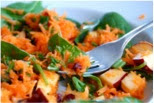What if I told you there is a pill that you could take and
the pill would know exactly what is wrong with you and exactly how to fix it?
Does this sound too good to be true? Well, you may be correct…but the good news
is there is a supplement that has similar healing powers. It knows the body’s
weaknesses and provides the necessary support to recreate balance. This
supplement is called an adaptogenic herb.
Vis consevatrix - or the body’s ability to heal itself - is
the core of adaptogenic herbs. These are herbs that support the body in its
ever-changing environment, and help it come back to a state of equilibrium. When the body experiences disease, it is said to be out of equilibrium. Adaptogens
rejuvenate the body and produce vitality by improving one’s ability to handle
stress, reduce pro-inflammatory pathways, and increase anabolic metabolism. There
are many different types of adaptogens, each with their own unique features. Many of them have scientific backing to
support their efficacy and safety, plus they have been used by herbalists for
thousands of years.

Some of the most commonly used adaptogenic herbs include
Ashwagandha, Rhodiola, Eluethero, Ginseng, and Holy Basil. Products found on
the market often contain a blend of different herbs and nutrients, while other
products contain standardized doses of an isolated herb. Both forms can be
effective, but no matter the form, it is most important to choose a high quality
product where the herbs have been grown, handled, used, and stored properly.

At the University of Maryland Integrative Medicine Clinic,
we offer Ashwagandha and Rhodiola supplements to our patients. Ashwagandha,
which means “strong as a horse,” promotes restful sleep and is often used
for a wide range of conditions including arthritis,
anxiety, respiratory disorders, and nervous system disorders (2). It can be
used on daily basis to broadly support physical and mental health and improve
longevity through its anti-inflammatory, anti-stress, immune boosting, and
rejuvenating properties. Modern research has shown this herb to protect against
cancer and cardiovascular disease (3, 4).

Rhodiola is a Russian herb that has been proven to enhance
mental and physical performance. It also improves the immune system, making it
a nice remedy for cold and flu prevention and treatment (5). Rhodiola has been
used for many other benefits including improved memory function and exercise
performance, stress management, sexual enhancement, reducing altitude sickness,
and more (5, 6, 7). Some believe it is best used as part of an adaptogenic
formulation, such as in the product Vital Adapt by Natura Health.
To learn more or to find out if these herbs may be right for
you, talk with your practitioner at the clinic today by calling 410-448-6361.
References:
1.
Yance, DR. Adaptogens in Medical Herbalism.
2013.
2.
C. Tohda, T. Kuboyama, K. Komatsu, and A.
Vanella, “Indian medicinal plants as antiradicals and DNA cleavage protectors,”
Phytomedicine 8(2) 2001:125-32
3.
S,K. Gupta, I. Mohanty, K.K. Talwar, et al.
Cardioprotection from ischemia and reperfusion injury by Withania somnifera: A
hemodynamic, biochemical and histopathological assessment. Molecular Cell Biochemistry. 260(1-2). 2004:39-47.
4.
K. Kaur, G. Rani, N. Widodo, et al. Evaluation
of the anti-proliferative and anti-oxidant activities of the leaf extract from
in vivo and in vitro raised ashwagandha. Food
and Chemical Toxicology. 42(12). 2004:2015-20.
5.
Brown, Gerbarg, and Ramazanov, “Rhodiola rosea.”
6.
Darbinyan, Kteyan, Panossian, et al., “Rhodiola
rosea in stress-induced fatigue” Abstracts of the Seminar on Rhodiola rosea,
June 18, 2002, Mikkeli, Finland.
7.
K. DeBock, B.O. Eijnde, M. Ramaekers, and P.
Hespel, “Acute Rhodiola rosea intake can improve endurance exercise
performance,” International Journal of
Sports Nutrition and Exercise Metabolism 14(3) 2004:298-307.












